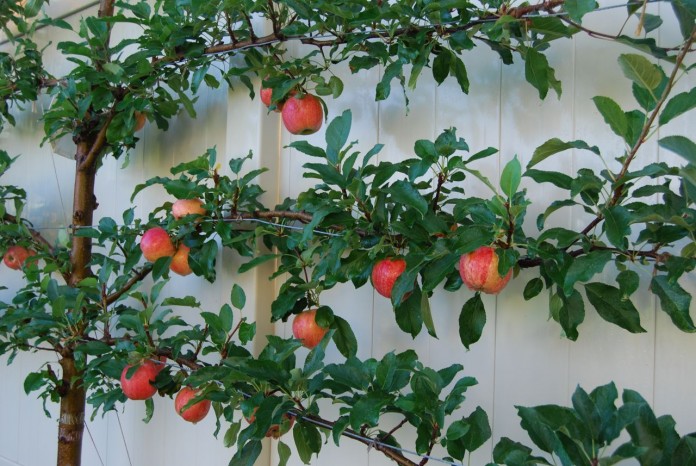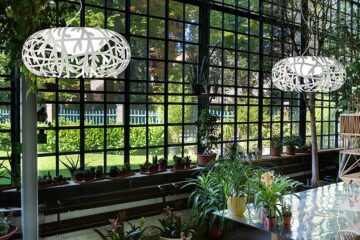The Art of Espalier: Training Fruit Trees into Beautiful and Productive Living Screens

In the world of gardening, there is a technique that combines the beauty of artistic design with the practicality of maximizing limited space – it’s called espalier. Espalier is the art of training fruit trees to grow flat against a wall, fence, or trellis, creating living screens that are both visually stunning and highly productive. This ancient horticultural practice has been revived and cherished by gardeners around the world, including the British gardening enthusiasts. In this article, we will delve into the fascinating world of espalier and explore how it can transform your garden into a fruitful and captivating space.
The Origins and History of Espalier Fruit Trees
Espalier has a rich history that spans centuries and various civilizations. The technique can be traced back to ancient civilizations such as Egypt and Rome, where it was used for practical purposes such as maximizing fruit production in limited spaces. Espalier gained prominence in European garden design during the Middle Ages and Renaissance, with monastic gardens and grand estates showcasing its beauty and functionality.
In Britain, espalier fruit trees became an integral part of gardening traditions, particularly during the reign of King Henry VIII. It adorned the walls of royal gardens, providing both sustenance and aesthetic appeal. Over time, the art of espalier spread to private gardens and became a cherished practice among British gardeners, who appreciated its elegance and efficiency.
The Benefits of Espalier Fruit Trees in Modern Gardens
As ChrisBowers specialists say: Espalier fruit trees offers numerous benefits for modern gardeners, making it a popular choice for those with limited space or a desire for functional and aesthetically pleasing garden features. One of the primary advantages of espalier is its ability to maximize fruit production in small areas. By training fruit trees along a flat surface, you can create a living screen that not only bears an abundance of fruits but also adds a unique charm to your garden.
Furthermore, espaliered fruit trees can serve as excellent privacy screens. Whether you want to block an unsightly view or create secluded outdoor spaces, espalier allows you to achieve both practicality and beauty. The dense foliage of trained fruit trees provides a natural barrier, enhancing the privacy of your garden while creating a serene and tranquil atmosphere.
In addition to its productivity and privacy benefits, espalier can help protect fruit trees from wind damage. By training the branches to grow horizontally against a support structure, you create a sturdy framework that reduces the tree’s vulnerability to strong winds. This not only safeguards the tree but also ensures that the fruits remain intact, promoting healthy and successful harvests.
Moreover, espaliered fruit trees add a touch of architectural interest to outdoor spaces. The carefully pruned branches, trained in intricate patterns, create a living work of art. Whether you opt for a fan-shaped espalier or a classic cordon form, the visual appeal of espaliered fruit trees is undeniable. They can transform an ordinary garden into a captivating and enchanting landscape, becoming a focal point that sparks conversation and admiration.
Suitable Fruit Trees for Espalier
When it comes to selecting fruit trees for espalier, certain varieties are more suitable for this technique in the British climate. Apple, pear, and cherry trees are among the popular choices. These fruit trees have flexible branches, making them easier to train and manipulate into desired shapes. Additionally, they adapt well to pruning and are known for their resilience in various weather conditions.
When choosing fruit trees for espalier, consider their growth habits and specific characteristics. Dwarf or semi-dwarf varieties are generally preferred, as they are more manageable and better suited for smaller spaces. It’s also important to select disease-resistant cultivars to ensure the long-term health and productivity of your espaliered trees. Take into account factors such as tree size, fruiting capabilities, and flavor preferences to make informed decisions when purchasing fruit tree saplings.
Choosing the Right Support Structures
To successfully espalier fruit trees, selecting the appropriate support structures is essential. The choice of support structure depends on the available space, aesthetic preferences, and practical considerations. Trellises, fences, and walls are commonly used as support systems for espaliered fruit trees.
Trellises offer versatility and can be customized to fit various garden styles. They provide a framework for the branches to grow against, creating a visually appealing backdrop. Fences, on the other hand, offer a natural and rustic charm while serving as a sturdy support for the trained branches. Walls are ideal for those seeking a more formal and structured look, lending a sense of grandeur to the espaliered fruit trees.
Consider the materials, installation process, and maintenance requirements when choosing support structures. Wood, metal, and wire are commonly used materials, each with its own benefits and aesthetic appeal. Ensure that the chosen structure can withstand the weight of the growing fruit trees and provide adequate support throughout their development.
Pruning and Training Techniques
Pruning and training are key aspects of espalier, as they determine the shape and form of the fruit trees. Several forms of espalier exist, each with its own unique characteristics and visual effects. The fan form, where the branches radiate from a central point, creates a striking display. The cordon form, characterized by a single vertical stem with lateral branches, is ideal for narrow spaces. The Belgian fence, a complex design involving multiple tiers of branches, adds a touch of elegance and grandeur to any garden.
Proper pruning techniques are crucial for maintaining the desired form and promoting fruit production. Pruning should be done during the dormant season, usually in late winter or early spring, to encourage healthy growth and shape development. Remove any dead, damaged, or crossing branches, and ensure a balanced distribution of branches along the support structure. Regular pruning throughout the growing season helps maintain the desired shape and controls the tree’s vigor.
Caring for Espaliered Fruit Trees
While espaliered fruit trees offer a visually captivating display, they require proper care to thrive and produce abundant harvests. Adequate watering is crucial, especially during dry spells, to ensure the trees receive sufficient moisture. Retaining moisture and preventing weed growth are two benefits of mulching around tree bases.
Fertilization is important for providing essential nutrients to the fruit trees. Apply a balanced fruit tree fertilizer in early spring and midsummer to support healthy growth and fruit development. Monitor for pests and diseases, and take appropriate measures to protect your trees. Regular inspections, prompt action, and organic pest control methods can help maintain the health of your espaliered fruit trees.
Conclusion
The art of espalier opens up a world of possibilities for gardeners, enabling them to transform their outdoor spaces into beautiful and productive living screens. From enhancing the aesthetic appeal of a garden to enjoying the bounty of homegrown fruits, espaliered fruit trees offer a unique combination of functionality and visual delight. By embracing the ancient technique of espalier, British gardeners can add a touch of artistry to their landscapes while making the most of limited gardening space. So why not embark on this rewarding journey and experience the magic of espalier in your own backyard?












